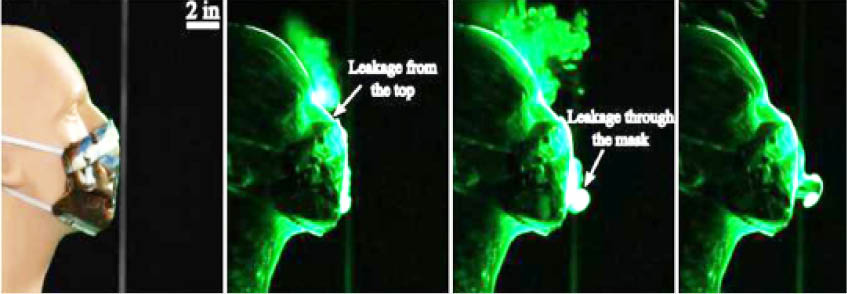Little was known about coronavirus, and since the outbreak started in December, researchers are uncovering more information every day.
Take the face mask. Advisories insist you should wear them as protection when going out. But with many still doubting whether the virus does exist, not many might take the face mask seriously.
New research shows you have to see to believe, by showing just how a mask—yes, your cloth mask, not the medical-grade one—can protect you from tiny respiratory droplets that come from someone coughing or sneezing around you. In the same way, you can stop passing on an infection to someone else.
Researchers from Florida Atlantic University’s College of Engineering and Computer Science, demonstrated a method to assess the effectiveness of face masks in obstructing droplets.
Obstructing droplets are the reason for wearing masks.
They used a flow visualisation in a laboratory and their finding is published in the journal Physics of Fluids.
The flow used a laser light sheet, a mixture of distilled water and glycerin to generate the synthetic fog that made up the content of a jet of cough.
They visualized droplets expelled from a mannequin’s mouth while simulating coughing and sneezing.
The masks tested include the regular cloth mask available, a single-layer bandana style covering, a homemade mask stitched using two-layers of cotton quilting fabric consisting of 70 threads per inch, and a non-sterile cone-style mask that is available in most pharmacies.
By placing these various masks on the mannequin, they were able to map out the paths of droplets and demonstrate how differently they perform.
Results showed that loosely folded facemasks and bandana-style coverings stop aerosolized respiratory droplets to some degree. However, well-fitted homemade masks with multiple layers of quilting fabric, and off-the-shelf cone style masks, proved to be the most effective in reducing droplet dispersal. These masks were able to curtail the speed and range of the respiratory jets significantly, albeit with some leakage through the mask material and from small gaps along the edges.
Importantly, uncovered emulated coughs were able to travel noticeably farther than the currently recommended 2-metre distancing guideline. Without a mask, droplets travelled nearly 2.5m; with a bandana, they travelled around 1m; with a folded cotton handkerchief, they travelled 0.3m; with the stitched quilted cotton mask, they travelled 0.006m; and with the cone-style mask, droplets travelled about 0.2 inches.
“In addition to providing an initial indication of the effectiveness of protective equipment, the visuals used in our study can help convey to the general public the rationale behind social-distancing guidelines and recommendations for using facemasks,” said Siddhartha Verma, Ph.D., lead author and an assistant professor who co-authored the paper with Manhar Dhanak, Ph.D., department chair, professor, and director of SeaTech; and John Frankenfeld, technical paraprofessional, all within FAU’s Department of Ocean and Mechanical Engineering.
When the mannequin was not fitted with a mask, they projected droplets much farther than the 2-metre distancing recommended. The researchers observed droplets travelling up to 4m within approximately 50 seconds.
Moreover, the tracer droplets remained suspended midair for up to three minutes in the quiescent environment. These observations, in combination with other recent studies, suggest that current social-distancing guidelines may need to be updated to account for the aerosol-based transmission of pathogens.
“We found that although the unobstructed turbulent jets were observed to travel up to 12 feet, a large majority of the ejected droplets fell to the ground by this point,” said Dhanak. “Importantly, both the number and concentration of the droplets will decrease with increasing distance, which is the fundamental rationale behind social-distancing.”
Credit: Florida Atlantic University, College of Engineering and Computer Science




